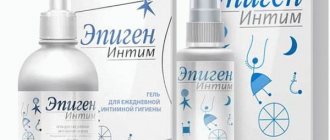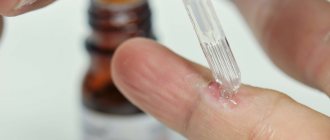Iodovidone 0.5% 30g spray for local and external use
pharmachologic effect
Antiseptic. It is iodine in the form of polyvinylpyrrolidone iodine complex. The concentration of active iodine is from 0.1% to 1%. Has a wide spectrum of antimicrobial action. Active against bacteria (including Mycobacterium tuberculosis), fungi, viruses, protozoa. Polyvinylpyrrolidone iodine is an iodophor that binds iodine. Upon contact with the skin and mucous membranes, iodine is gradually and evenly released, exerting a bactericidal effect on microorganisms. At the site of application of povidone-iodine preparations, a thin colored layer remains, which remains until all the iodine is released, after which its effect ceases.
Composition and release form Yodovidone 0.5% 30g spray for local and external use
Spray - 1 bottle:
- Active substance: povidone-iodine 1.38 g.
- Excipients: levomenthol 0.3 g, ethanol 95% 6 g, propylene glycol 9 g, sodium phosphate dodecahydrate to regulate pH, purified water to obtain 30 g of the drug.
30 g - aluminum cylinders (1) - cardboard packs.
Description of the dosage form
Spray for local and external use; in the form of a red-brown transparent liquid; slight opalescence is allowed.
Directions for use and doses
Individual, depending on the indications and dosage form used.
Pharmacodynamics
Povidone-iodine is an antiseptic, which is a complex of iodine and povidone, effective at a pH of 2 to 7.
The bactericidal effect is due to free active iodine, which is released from the povidone-iodine complex. Free iodine, as a strong oxidizing agent, reacts at the molecular level with insoluble fatty acids and practically non-oxidizable SH- and OH-groups of amino acids in the enzymes and main structural components of bacteria, both gram-positive and gram-negative, mycobacteria, fungi, especially the genus Candida (Candida), various viruses and some protozoa.
However, for complete inactivation of some viruses and bacterial spores, a sufficiently long period of exposure to the drug is required.
There are no known cases of the development of resistance in microorganisms with long-term use of povidone-iodine.
Pharmacokinetics
With prolonged use of the drug and/or use on a large wound surface and mucous membranes, systemic absorption of iodine may occur, which may affect tests of the functional activity of the thyroid gland.
Iodine in the body is converted into iodides, which are excreted mainly by the kidneys, as well as a small amount through the intestines, with saliva and sweat.
Iodides pass through the placental barrier and penetrate into mother's milk.
Indications for use Iodovidone 0.5% 30g spray for local and external use
For treating the patient’s skin before and after operations, research (biopsy, puncture, blood drawing, injections, etc.), pre- and postoperative treatment of the hands of surgeons, medical personnel, hygienic treatment of hands when caring for infected patients, treatment of instruments and patient care items.
For local use: infections of the nasopharynx, treatment of infected skin lesions (burns, wounds, ulcers, abrasions), prevention of infection of wound surfaces, treatment of nonspecific vaginitis, trichomoniasis.
Contraindications
Hyperthyroidism, thyroid adenoma, renal failure, pregnancy, lactation (breastfeeding), hypersensitivity to iodine. Cannot be used to treat the skin of premature and newborn babies.
Application of Iodovidone 0.5% 30g spray for local and external use during pregnancy and lactation
Contraindicated during pregnancy and lactation.
Use in children
Cannot be used to treat the skin of premature and newborn babies.
special instructions
Povidone-iodine solution should not be used in combination with other antiseptics or enzymatic ointments. Before systematic use of povidone-iodine preparations, trial use is advisable. In the presence of blood, the bactericidal effect of povidone-iodine may be reduced. Avoid contact of povidone-iodine preparations with the eyes.
Overdose
If the drug is accidentally ingested, the following symptoms may occur: anuria, collapse, laryngeal edema, pulmonary edema.
It is necessary to perform gastric lavage, and to eliminate the symptoms of overdose, symptomatic therapy is carried out.
With intense iodine absorption over a long period, the following symptoms may be noted: tachycardia, restlessness, tremors and headache. In this case, you should immediately stop using the drug and consult a doctor.
Side effects Yodovidone 0.5% 30g spray for local and external use
Local manifestations of hypersensitivity to iodine (itching, hyperemia) are possible, which requires discontinuation of treatment.
Drug interactions
Pharmaceutically incompatible with disinfectants containing mercury; oxidizing agents, alkali salts and acidic substances.
Iodovidone spray for local and external use approx 30 g x1
ATX code: D08AG02 (Povidone-iodine) Active substance: povidone-iodine (povidone-iodine) BAN accepted for use in the UK Dosage form IODOVIDONE spray for local use. and external approx. 1.38 g: 30 g cylinders reg. No.: LP-001163 from 11.11.11 - Valid Release form, composition and packaging Spray for local and external use in the form of a red-brown transparent liquid, slight opalescence is allowed.
1 cylinder povidone-iodine 1.38 g
Excipients: levomenthol 0.3 g, ethanol 95% 6 g, propylene glycol 9 g, sodium phosphate dodecahydrate to regulate pH, purified water to obtain 30 g of the drug.
30 g - aluminum cylinders (1) - cardboard packs.
Clinical-pharmacological group: Antiseptic for external and local use Pharmaco-therapeutic group: Antiseptic Pharmacological action Information on the drug is available only to specialists. Login or Register Indications For treating the patient's skin before and after operations, research (biopsy, puncture, blood drawing, injections, etc.), pre- and postoperative treatment of the hands of surgeons, medical personnel, hygienic treatment of hands when caring for infected patients , processing of instruments and patient care items.
For local use: infections of the nasopharynx, treatment of infected skin lesions (burns, wounds, ulcers, abrasions), prevention of infection of wound surfaces, treatment of nonspecific vaginitis, trichomoniasis.
ICD-10 codes ICD-10 code Indication A59 Trichomoniasis J00 Acute nasopharyngitis N76 Other inflammatory diseases of the vagina and vulva T14.0 Superficial injury to an unspecified area of the body (including abrasion, bruise, contusion, hematoma, non-venomous insect bite) T30 Thermal and chemical burns of unspecified location T79.3 Post-traumatic wound infection, not elsewhere classified Z29.2 Other type of prophylactic chemotherapy (administration of antibiotics for prophylactic purposes)
Dosage regimen Individual, depending on the indications and the dosage form used. Side effects Local manifestations of hypersensitivity to iodine (itching, hyperemia) are possible, which requires discontinuation of treatment. Contraindications for use Hyperthyroidism, thyroid adenoma, renal failure, pregnancy, lactation (breastfeeding), hypersensitivity to iodine. Cannot be used to treat the skin of premature and newborn babies. Use during pregnancy and lactation Contraindicated during pregnancy and lactation. Use for impaired renal function Contraindicated in renal failure. Use in children Do not use for treating the skin of premature and newborn babies. Special instructions Povidone-iodine solution should not be used in combination with other antiseptic agents or enzymatic ointments. Before systematic use of povidone-iodine preparations, trial use is advisable. In the presence of blood, the bactericidal effect of povidone-iodine may be reduced. Avoid contact of povidone-iodine preparations with the eyes. Drug interactions Pharmaceutically incompatible with disinfectants containing mercury, oxidizing agents, alkali salts and acidic substances.
Iodovidone spray for places and external use 0.5% 30g
Release form, packaging and composition of the drug Yodovidone
Spray for local and external use in the form of a red-brown transparent liquid;
slight opalescence is allowed. 1 cylinder
povidone-iodine 1.38 g
Excipients: levomenthol 0.3 g, ethanol 95% 6 g, propylene glycol 9 g, sodium phosphate dodecahydrate to regulate pH, purified water to obtain 30 g of the drug.
30 g - aluminum cylinders (1) - cardboard packs.
Clinical and pharmacological group: Antiseptic for external and local use
Pharmacotherapeutic group: Antiseptic
pharmachologic effect
Antiseptic and disinfectant. Released from the complex with polyvinylpyrrolidone upon contact with the skin and mucous membranes, iodine forms iodamines with bacterial cell proteins, coagulates them and causes the death of microorganisms. It has a rapid bactericidal effect on gram-positive and gram-negative bacteria (with the exception of Mycobacterium tuberculosis). Effective against fungi, viruses, protozoa.
Pharmacokinetics
When applied topically, there is almost no absorption of iodine.
Indications of the active substances of the drug Iodovidone
Treatment and prevention of wound infections in surgery, traumatology, combustiology, dentistry; treatment of bacterial, fungal and viral skin infections, prevention of superinfection in dermatological practice; treatment of bedsores, trophic ulcers, diabetic foot; disinfection of the skin and mucous membranes of patients in preparation for surgical interventions, invasive studies (including punctures, biopsies, injections); disinfection of the skin around drainages, catheters, probes; disinfection of the oral cavity during dental operations; disinfection of the birth canal during “minor” gynecological operations (including artificial termination of pregnancy, insertion of an IUD, coagulation of erosion and polyp. For hygienic treatment of the hands of surgeons and medical personnel.
Dosage regimen
The method of administration and dosage regimen of a particular drug depend on its release form and other factors. The optimal dosage regimen is determined by the doctor. The compliance of the dosage form of a particular drug with the indications for use and dosage regimen should be strictly observed.
The dosage regimen is individual, depending on the indications for use and the dosage form used.
Side effect
Possible: with frequent use over a large area of the wound surface and mucous membranes, systemic reabsorption of iodine may occur, which may affect tests of the functional activity of the thyroid gland. Hypersensitivity reactions, possible manifestations of an allergic reaction (hyperemia, burning, itching, swelling, pain), which requires discontinuation of povidiodine.
Contraindications for use
Hypersensitivity to iodine; dysfunction of the thyroid gland (hyperthyroidism); thyroid adenoma; Dühring's dermatitis herpetiformis; simultaneous use of radioactive iodine; premature and newborn babies.
Carefully
Chronic renal failure, pregnancy, breastfeeding period.
Use during pregnancy and breastfeeding
The use of povido-iodine is not recommended from the 3rd month of pregnancy and during lactation (breastfeeding). If necessary, in these cases, treatment is possible under individual medical supervision.
Use for renal impairment
Caution should be exercised when used regularly on damaged skin in patients with chronic renal failure.
Use in children
Contraindication: premature and newborn babies.
Use in elderly patients
Use with caution in elderly patients to avoid the risk of exacerbation of chronic diseases.
special instructions
In case of dysfunction of the thyroid gland, the use of the drug is possible only under the strict supervision of a doctor.
Caution should be exercised when used regularly on damaged skin in patients with chronic renal failure.
A colored film is formed at the site of application, which persists until the entire amount of active iodine is released, which means the cessation of the action of the active substance.
Coloring on leather and fabrics is easily washed off with water.
Do not use for bites from insects, domestic or wild animals.
Drug interactions
Incompatible with other antiseptics, especially those containing alkalis, enzymes and mercury.
In the presence of blood, the bactericidal effect may decrease, but with increasing concentration of the active substance, the bactericidal activity may be increased.


